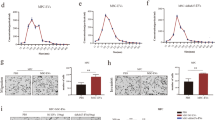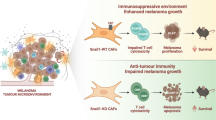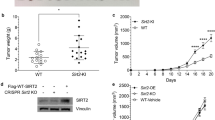Abstract
Tenascin-C (TNC) is highly expressed in melanoma; however, little is known about its functions. Recent studies indicate that TNC has a role within the stem cell niche. We hypothesized that TNC creates a specific environment for melanoma cells to show a stem cell-like phenotype, promoting tumor growth and evading conventional therapies. TNC expression was strongly upregulated in melanoma cells grown as 3D spheres (enriched for stem-like cells) when compared to adherent cells. Downmodulation of TNC by shRNA lentiviruses significantly decreased the growth of melanoma spheres. The incidence of pulmonary metastases after intravenous injection of TNC knockdown cells was significantly lower in NOD/SCID IL2Rγnull mice compared with control cells. Melanoma spheres contain an increased number of side population (SP) cells, which show stem cell characteristics, and have the potential for drug resistance due to their high efflux capacity. Knockdown of TNC dramatically decreased the SP fraction in melanoma spheres and lowered their resistance to doxorubicin treatment, likely because of the downregulation of multiple ATP-binding cassette (ABC) transporters, including ABCB5. These data suggest that TNC is critical in melanoma progression as it mediates protective signals in the therapy-resistant population of melanoma.
This is a preview of subscription content, access via your institution
Access options
Subscribe to this journal
Receive 50 print issues and online access
$259.00 per year
only $5.18 per issue
Buy this article
- Purchase on Springer Link
- Instant access to full article PDF
Prices may be subject to local taxes which are calculated during checkout







Similar content being viewed by others
References
Bidard FC, Pierga JY, Vincent-Salomon A, Poupon MF . (2007). A ‘class action’ against the microenvironment: do cancer cells cooperate in metastasis? Cancer Metastasis Rev 27: 5–10.
Bornstein P, Sage EH . (2002). Matricellular proteins: extracellular modulators of cell function. Curr Opin Cell Biol 14: 608–616.
Brigstock DR . (1999). The connective tissue growth factor/cysteine-rich 61/nephroblastoma overexpressed (CCN) family. Endocr Rev 20: 189–206.
Chiquet-Ehrismann R, Chiquet M . (2003). Tenascins: regulation and putative functions during pathological stress. J Pathol 200: 488–499.
Cohen ED, Ihida-Stansbury K, Lu MM, Panettieri RA, Jones PL, Morrisey EE . (2009). Wnt signaling regulates smooth muscle precursor development in the mouse lung via a tenascin C/PDGFR pathway. J Clin Invest 119: 2538–2549.
Dick JE . (2008). Stem cell concepts renew cancer research. Blood 112: 4793–4807.
Fang D, Nguyen TK, Leishear K, Finko R, Kulp AN, Hotz S et al. (2005). A tumorigenic subpopulation with stem cell properties in melanomas. Cancer Res 65: 9328–9337.
Frank NY, Margaryan A, Huang Y, Schatton T, Waaga-Gasser AM, Gasser M et al. (2005). ABCB5-mediated doxorubicin transport and chemoresistance in human malignant melanoma. Cancer Res 65: 4320–4333.
Fukunaga-Kalabis M, Martinez G, Liu ZJ, Kalabis J, Mrass P, Weninger W et al. (2006). CCN3 controls 3D spatial localization of melanocytes in the human skin through DDR1. J Cell Biol 175: 563–569.
Garcion E, Halilagic A, Faissner A, ffrench-Constant C . (2004). Generation of an environmental niche for neural stem cell development by the extracellular matrix molecule tenascin C. Development 131: 3423–3432.
Goodell MA, Brose K, Paradis G, Conner AS, Mulligan RC . (1996). Isolation and functional properties of murine hematopoietic stem cells that are replicating in vivo. J Exp Med 183: 1797–1806.
Grichnik JM, Burch JA, Schulteis RD, Shan S, Liu J, Darrow TL et al. (2006). Melanoma, a tumor based on a mutant stem cell? J Invest Dermatol 126: 142–153.
Helleman J, Jansen MP, Ruigrok-Ritstier K, van Staveren IL, Look MP, Meijer-van Gelder ME et al. (2008). Association of an extracellular matrix gene cluster with breast cancer prognosis and endocrine therapy response. Clin Cancer Res 14: 5555–5564.
Herlyn M, Graeven U, Speicher D, Sela BA, Bennicelli JL, Kath R et al. (1991). Characterization of tenascin secreted by human melanoma cells. Cancer Res 51: 4853–4858.
Hsu MY, Shih DT, Meier FE, Van Belle P, Hsu JY, Elder DE et al. (1998). Adenoviral gene transfer of beta3 integrin subunit induces conversion from radial to vertical growth phase in primary human melanoma. Am J Pathol 153: 1435–1442.
Jang JH, Chung CP . (2005). Tenascin-C promotes cell survival by activation of Akt in human chondrosarcoma cell. Cancer Lett 229: 101–105.
Jones PL, Crack J, Rabinovitch M . (1997). Regulation of tenascin-C, a vascular smooth muscle cell survival factor that interacts with the alpha v beta 3 integrin to promote epidermal growth factor receptor phosphorylation and growth. J Cell Biol 139: 279–293.
Jonker JW, Freeman J, Bolscher E, Musters S, Alvi AJ, Titley I et al. (2005). Contribution of the ABC transporters Bcrp1 and Mdr1a/1b to the side population phenotype in mammary gland and bone marrow of mice. Stem Cells 23: 1059–1065.
Kabashima A, Higuchi H, Takaishi H, Matsuzaki Y, Suzuki S, Izumiya M et al. (2009). Side population of pancreatic cancer cells predominates in TGF-beta-mediated epithelial to mesenchymal transition and invasion. Int J Cancer 124: 2771–2779.
Katoh SY, Ueno M, Takakura N . (2008). Involvement of MDR1 function in proliferation of tumour cells. J Biochem 143: 517–524.
Kloepper JE, Tiede S, Brinckmann J, Reinhardt DP, Meyer W, Faessler R et al. (2008). Immunophenotyping of the human bulge region: the quest to define useful in situ markers for human epithelial hair follicle stem cells and their niche. Exp Dermatol 17: 592–609.
Kuo MT, Liu Z, Wei Y, Lin-Lee YC, Tatebe S, Mills GB et al. (2002). Induction of human MDR1 gene expression by 2-acetylaminofluorene is mediated by effectors of the phosphoinositide 3-kinase pathway that activate NF-kappaB signaling. Oncogene 21: 1945–1954.
Marchionini DM, Collier TJ, Camargo M, McGuire S, Pitzer M, Sortwell CE . (2003). Interference with anoikis-induced cell death of dopamine neurons: implications for augmenting embryonic graft survival in a rat model of Parkinson's disease. J Comp Neurol 464: 172–179.
Matsuzaki Y, Besnard V, Clark JC, Xu Y, Wert SE, Ikegami M et al. (2008). STAT3 regulates ABCA3 expression and influences lamellar body formation in alveolar type II cells. Am J Respir Cell Mol Biol 38: 551–558.
Mouthon MA, Fouchet P, Mathieu C, Sii-Felice K, Etienne O, Lages CS et al. (2006). Neural stem cells from mouse forebrain are contained in a population distinct from the ‘side population’. J Neurochem 99: 807–817.
Murphy-Ullrich JE . (2001). The de-adhesive activity of matricellular proteins: is intermediate cell adhesion an adaptive state? J Clin Invest 107: 785–790.
Nakanishi T, Shiozawa K, Hassel BA, Ross DD . (2006). Complex interaction of BCRP/ABCG2 and imatinib in BCR-ABL-expressing cells: BCRP-mediated resistance to imatinib is attenuated by imatinib-induced reduction of BCRP expression. Blood 108: 678–684.
Nilsson SK, Johnston HM, Whitty GA, Williams B, Webb RJ, Denhardt DT et al. (2005). Osteopontin, a key component of the hematopoietic stem cell niche and regulator of primitive hematopoietic progenitor cells. Blood 106: 1232–1239.
Nishii T, Yashiro M, Shinto O, Sawada T, Ohira M, Hirakawa K . (2009). Cancer stem cell-like SP cells have a high adhesion ability to the peritoneum in gastric carcinoma. Cancer Sci 100: 1397–1402.
Orend G, Chiquet-Ehrismann R . (2006). Tenascin-C induced signaling in cancer. Cancer Lett 244: 143–163.
Perbal B . (2004). CCN proteins: multifunctional signalling regulators. Lancet 363: 62–64.
Qin XF, An DS, Chen IS, Baltimore D . (2003). Inhibiting HIV-1 infection in human T cells by lentiviral-mediated delivery of small interfering RNA against CCR5. Proc Natl Acad Sci USA 100: 183–188.
Quintana E, Shackleton M, Sabel MS, Fullen DR, Johnson TM, Morrison SJ . (2008). Efficient tumour formation by single human melanoma cells. Nature 456: 593–598.
Refaeli Y, Bhoumik A, Roop DR, Ronai ZA . (2009). Melanoma-initiating cells: a compass needed. EMBO Rep 10: 965–972.
Reya T, Morrison SJ, Clarke MF, Weissman IL . (2001). Stem cells, cancer, and cancer stem cells. Nature 414: 105–111.
Roesch A, Fukunaga-Kalabis M, Schmidt EC, Zabierowski SE, Brafford PA, Vultur A et al. (2010). A temporarily distinct subpopulation of slow-cycling melanoma cells is required for continuous tumor growth. Cell 141: 583–594.
Scharenberg CW, Harkey MA, Torok-Storb B . (2002). The ABCG2 transporter is an efficient Hoechst 33342 efflux pump and is preferentially expressed by immature human hematopoietic progenitors. Blood 99: 507–512.
Schatton T, Murphy GF, Frank NY, Yamaura K, Waaga-Gasser AM, Gasser M et al. (2008). Identification of cells initiating human melanomas. Nature 451: 345–349.
Sethi T, Rintoul RC, Moore SM, MacKinnon AC, Salter D, Choo C et al. (1999). Extracellular matrix proteins protect small cell lung cancer cells against apoptosis: a mechanism for small cell lung cancer growth and drug resistance in vivo. Nat Med 5: 662–668.
Susanto J, Lin YH, Chen YN, Shen CR, Yan YT, Tsai ST et al. (2008). Porphyrin homeostasis maintained by ABCG2 regulates self-renewal of embryonic stem cells. PLoS One 3: e4023.
Thomson JA, Itskovitz-Eldor J, Shapiro SS, Waknitz MA, Swiergiel JJ, Marshall VS et al. (1998). Embryonic stem cell lines derived from human blastocysts. Science 282: 1145–1147.
Tuominen H, Kallioinen M . (1994). Increased tenascin expression in melanocytic tumors. J Cutan Pathol 21: 424–429.
Villuendas R, Steegmann JL, Pollan M, Tracey L, Granda A, Fernandez-Ruiz E et al. (2006). Identification of genes involved in imatinib resistance in CML: a gene-expression profiling approach. Leukemia 20: 1047–1054.
Wicha MS, Liu S, Dontu G . (2006). Cancer stem cells: an old idea—a paradigm shift. Cancer Res 66: 1883–1890; discussion 1895-1896.
Xu C, Inokuma MS, Denham J, Golds K, Kundu P, Gold JD et al. (2001). Feeder-free growth of undifferentiated human embryonic stem cells. Nat Biotechnol 19: 971–974.
Zhang H, Bajraszewski N, Wu E, Wang H, Moseman AP, Dabora SL et al. (2007). PDGFRs are critical for PI3K/Akt activation and negatively regulated by mTOR. J Clin Invest 117: 730–738.
Acknowledgements
This work was supported by grants from the NCI (CA25874, CA47159, CA93372, CA10815). We thank Angela Cipolla, Sarah Telson and Kate M Belser for technical assistance. This work was also supported by Ellen Heber-Katz, James Hayden and Frederick Keeney (The Wistar Microscopy Facility), Russell Delgiacco (The Wistar Histotechnology Facility), Jonni Moore and Hank Fletcher (University of Pennsylvania, Flow Cytometry Core Facility) and The Wistar Animal Facility.
Author information
Authors and Affiliations
Corresponding author
Ethics declarations
Competing interests
The authors declare no conflict of interest.
Additional information
Supplementary Information accompanies the paper on the Oncogene website
Rights and permissions
About this article
Cite this article
Fukunaga-Kalabis, M., Martinez, G., Nguyen, T. et al. Tenascin-C promotes melanoma progression by maintaining the ABCB5-positive side population. Oncogene 29, 6115–6124 (2010). https://doi.org/10.1038/onc.2010.350
Received:
Revised:
Accepted:
Published:
Issue Date:
DOI: https://doi.org/10.1038/onc.2010.350
Keywords
This article is cited by
-
Tenascin-C promotes bladder cancer progression and its action depends on syndecan-4 and involves NF-κB signaling activation
BMC Cancer (2022)
-
Androgen receptor variant-7 regulation by tenascin-c induced src activation
Cell Communication and Signaling (2022)
-
Splicing factor SRSF6 promotes hyperplasia of sensitized skin
Nature Structural & Molecular Biology (2014)
-
Melanoma stem cells and metastasis: mimicking hematopoietic cell trafficking?
Laboratory Investigation (2014)
-
Long-term efficiency of mesenchymal stromal cell-mediated CD-MSC/5FC therapy in human melanoma xenograft model
Gene Therapy (2014)



